LCBS5001 Strategic Management: A Strategic Analysis Report on Nokia
VerifiedAdded on 2023/06/14
|28
|6911
|118
Report
AI Summary
This report provides a comprehensive strategic analysis of Nokia, a company that experienced significant shifts in its market position. It delves into the company's history, mission, and values, followed by an external environmental analysis using PESTLE and Porter's Five Forces to assess Nokia's competitive landscape. The internal analysis employs SWOT to evaluate Nokia's strategic capabilities. Bowman’s Strategy Clock Model helps to assess Nokia's competitive positioning. The report further examines strategic choices using the Ansoff Matrix, focusing on market penetration and product development strategies. Finally, it offers recommendations for Nokia to regain market share through collaboration, design improvements, and enhanced customer service. Desklib offers a wealth of similar documents and study tools for students.
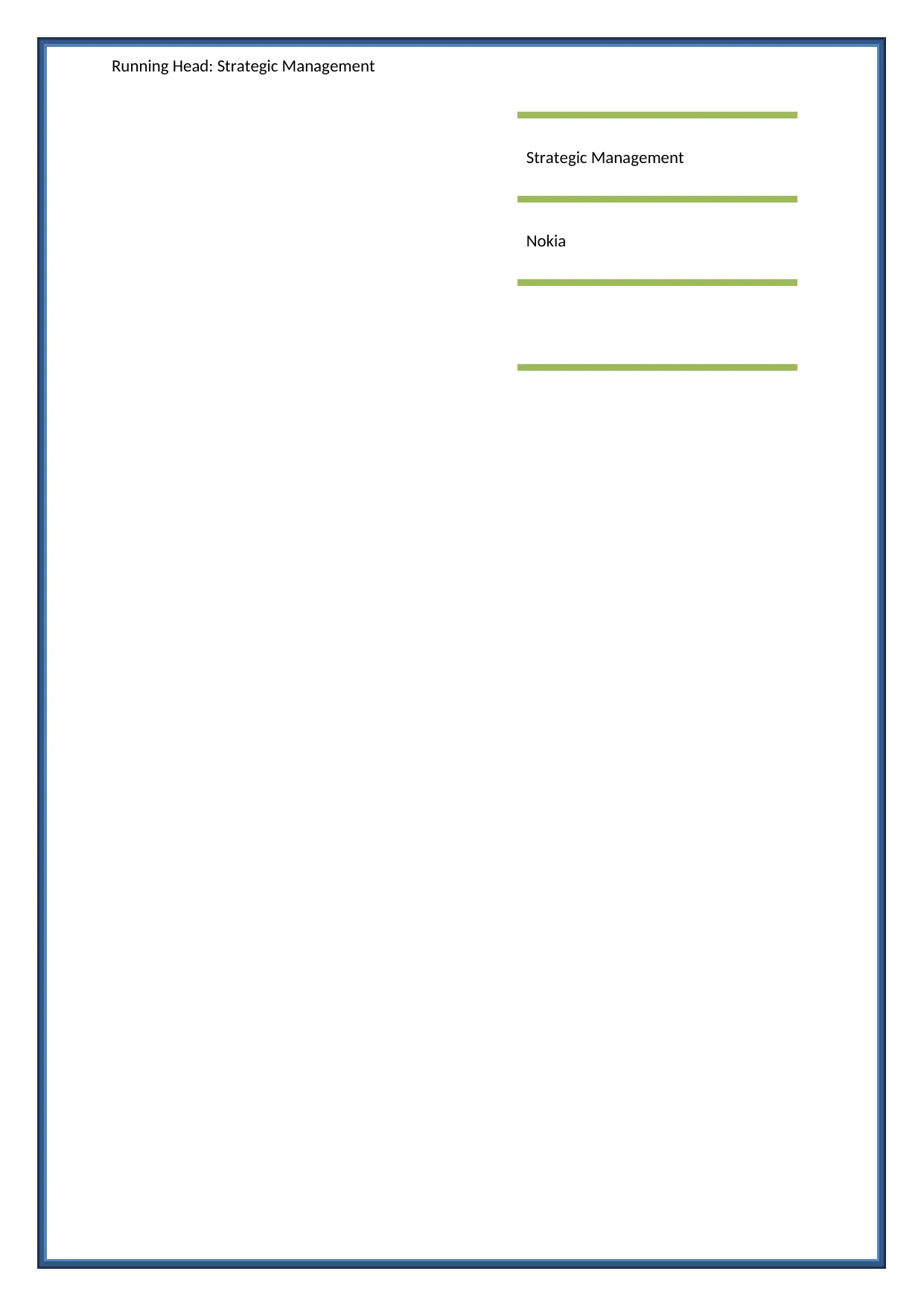
Running Head: Strategic Management
Strategic Management
Nokia
Strategic Management
Nokia
Paraphrase This Document
Need a fresh take? Get an instant paraphrase of this document with our AI Paraphraser
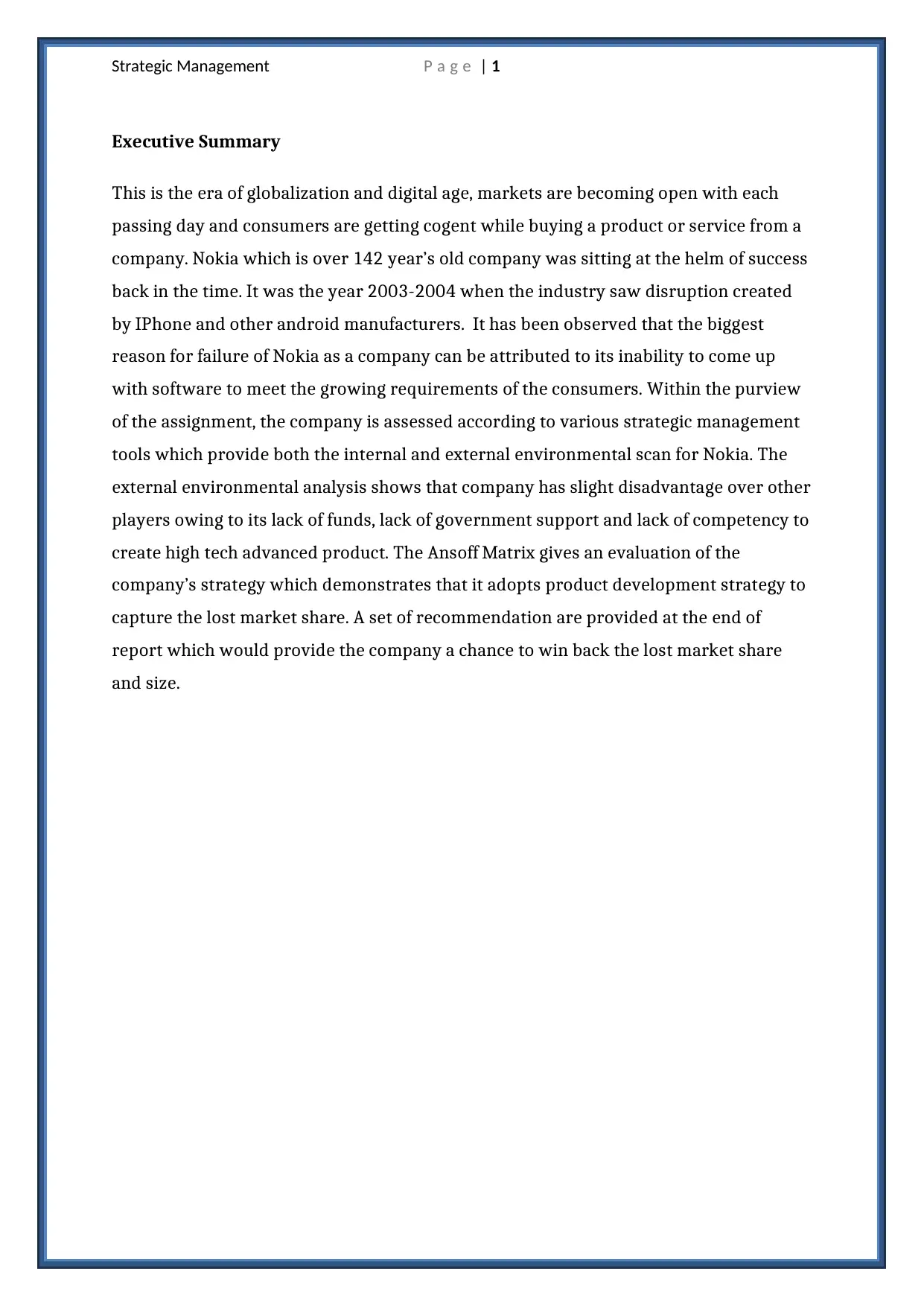
Strategic Management P a g e | 1
Executive Summary
This is the era of globalization and digital age, markets are becoming open with each
passing day and consumers are getting cogent while buying a product or service from a
company. Nokia which is over 142 year’s old company was sitting at the helm of success
back in the time. It was the year 2003-2004 when the industry saw disruption created
by IPhone and other android manufacturers. It has been observed that the biggest
reason for failure of Nokia as a company can be attributed to its inability to come up
with software to meet the growing requirements of the consumers. Within the purview
of the assignment, the company is assessed according to various strategic management
tools which provide both the internal and external environmental scan for Nokia. The
external environmental analysis shows that company has slight disadvantage over other
players owing to its lack of funds, lack of government support and lack of competency to
create high tech advanced product. The Ansoff Matrix gives an evaluation of the
company’s strategy which demonstrates that it adopts product development strategy to
capture the lost market share. A set of recommendation are provided at the end of
report which would provide the company a chance to win back the lost market share
and size.
Executive Summary
This is the era of globalization and digital age, markets are becoming open with each
passing day and consumers are getting cogent while buying a product or service from a
company. Nokia which is over 142 year’s old company was sitting at the helm of success
back in the time. It was the year 2003-2004 when the industry saw disruption created
by IPhone and other android manufacturers. It has been observed that the biggest
reason for failure of Nokia as a company can be attributed to its inability to come up
with software to meet the growing requirements of the consumers. Within the purview
of the assignment, the company is assessed according to various strategic management
tools which provide both the internal and external environmental scan for Nokia. The
external environmental analysis shows that company has slight disadvantage over other
players owing to its lack of funds, lack of government support and lack of competency to
create high tech advanced product. The Ansoff Matrix gives an evaluation of the
company’s strategy which demonstrates that it adopts product development strategy to
capture the lost market share. A set of recommendation are provided at the end of
report which would provide the company a chance to win back the lost market share
and size.
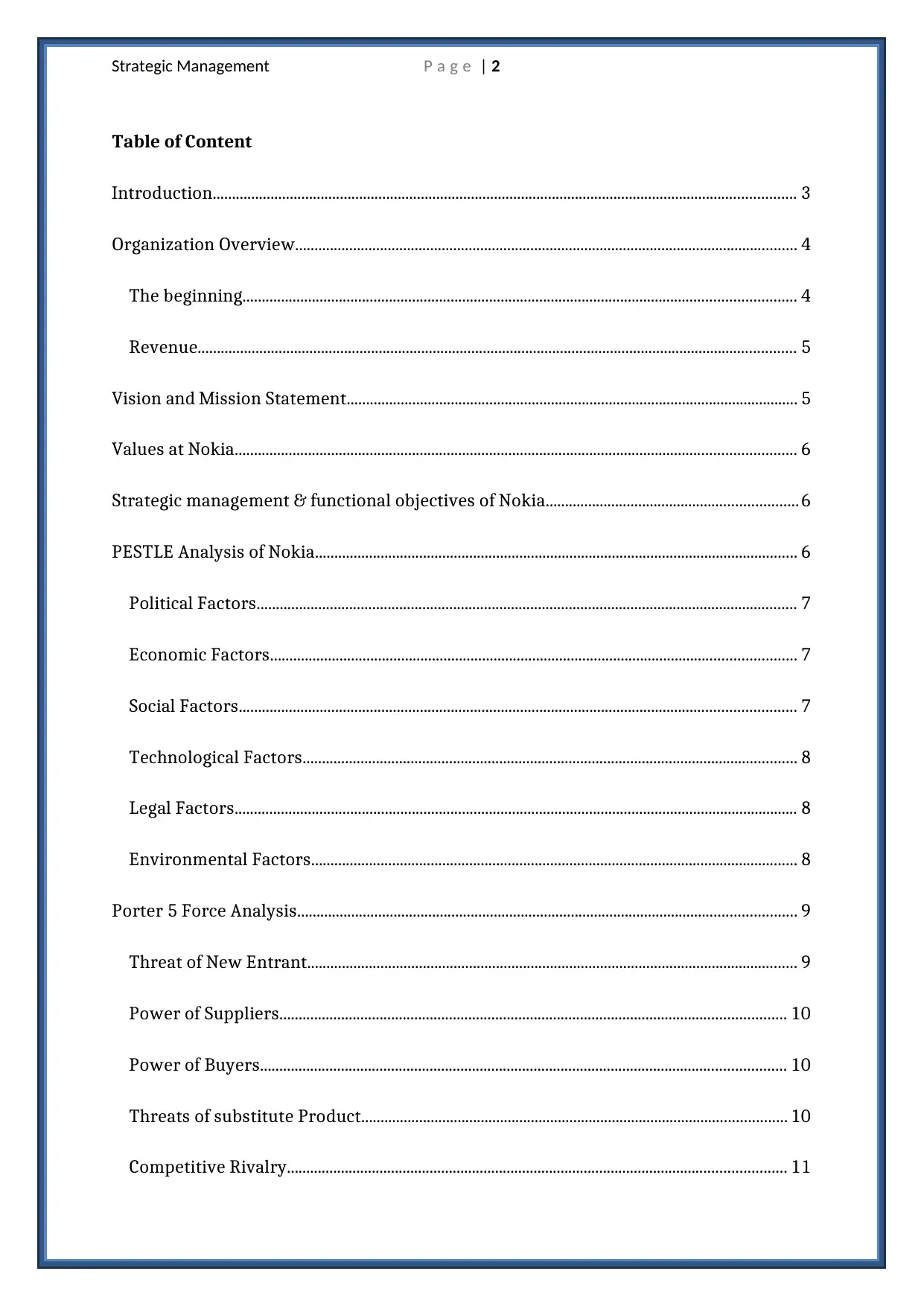
Strategic Management P a g e | 2
Table of Content
Introduction....................................................................................................................................................... 3
Organization Overview.................................................................................................................................. 4
The beginning............................................................................................................................................... 4
Revenue........................................................................................................................................................... 5
Vision and Mission Statement..................................................................................................................... 5
Values at Nokia................................................................................................................................................. 6
Strategic management & functional objectives of Nokia.................................................................6
PESTLE Analysis of Nokia............................................................................................................................. 6
Political Factors............................................................................................................................................ 7
Economic Factors........................................................................................................................................ 7
Social Factors................................................................................................................................................ 7
Technological Factors................................................................................................................................ 8
Legal Factors.................................................................................................................................................. 8
Environmental Factors.............................................................................................................................. 8
Porter 5 Force Analysis................................................................................................................................. 9
Threat of New Entrant............................................................................................................................... 9
Power of Suppliers................................................................................................................................... 10
Power of Buyers........................................................................................................................................ 10
Threats of substitute Product.............................................................................................................. 10
Competitive Rivalry................................................................................................................................. 11
Table of Content
Introduction....................................................................................................................................................... 3
Organization Overview.................................................................................................................................. 4
The beginning............................................................................................................................................... 4
Revenue........................................................................................................................................................... 5
Vision and Mission Statement..................................................................................................................... 5
Values at Nokia................................................................................................................................................. 6
Strategic management & functional objectives of Nokia.................................................................6
PESTLE Analysis of Nokia............................................................................................................................. 6
Political Factors............................................................................................................................................ 7
Economic Factors........................................................................................................................................ 7
Social Factors................................................................................................................................................ 7
Technological Factors................................................................................................................................ 8
Legal Factors.................................................................................................................................................. 8
Environmental Factors.............................................................................................................................. 8
Porter 5 Force Analysis................................................................................................................................. 9
Threat of New Entrant............................................................................................................................... 9
Power of Suppliers................................................................................................................................... 10
Power of Buyers........................................................................................................................................ 10
Threats of substitute Product.............................................................................................................. 10
Competitive Rivalry................................................................................................................................. 11
⊘ This is a preview!⊘
Do you want full access?
Subscribe today to unlock all pages.

Trusted by 1+ million students worldwide
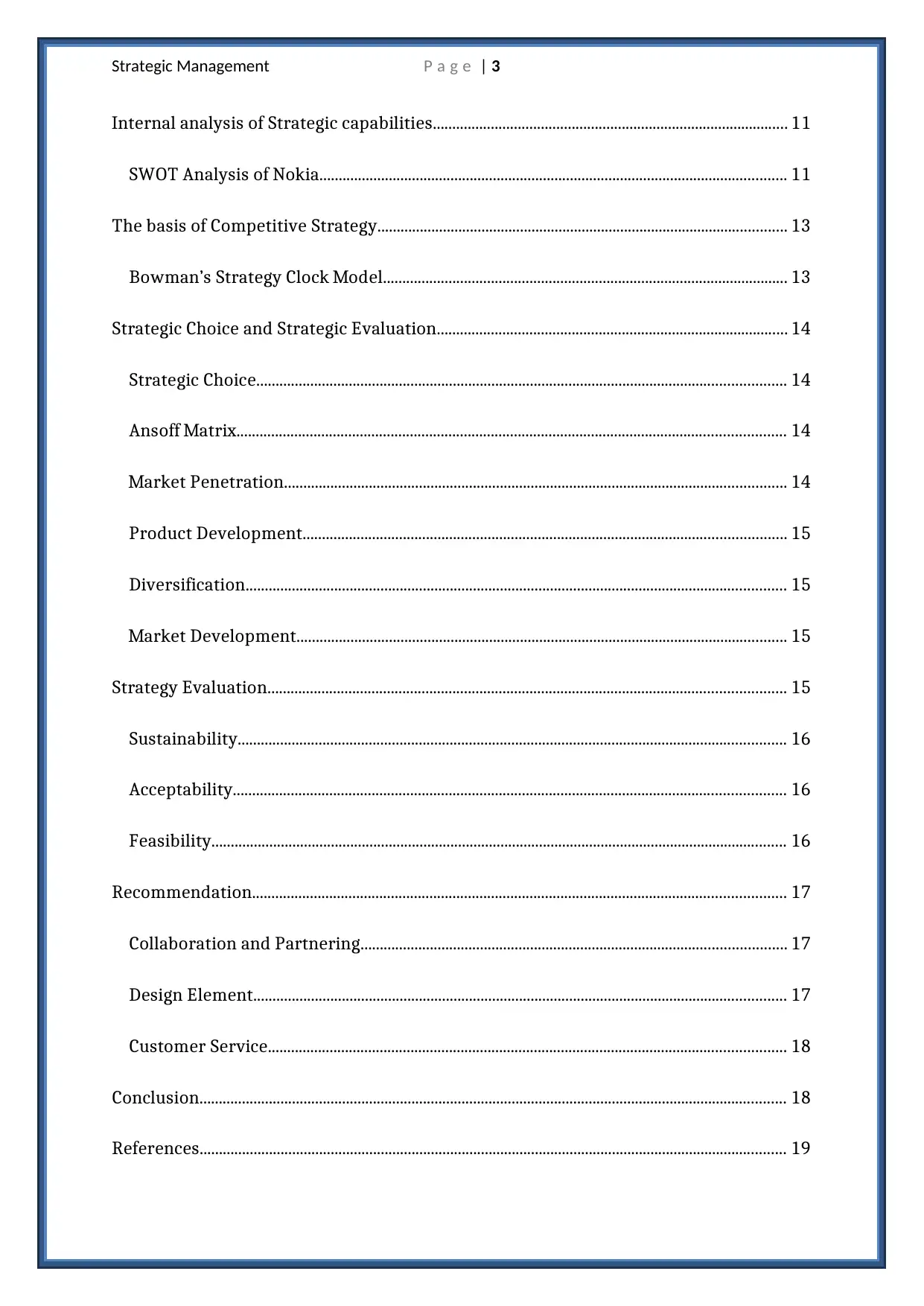
Strategic Management P a g e | 3
Internal analysis of Strategic capabilities............................................................................................ 11
SWOT Analysis of Nokia......................................................................................................................... 11
The basis of Competitive Strategy.......................................................................................................... 13
Bowman’s Strategy Clock Model......................................................................................................... 13
Strategic Choice and Strategic Evaluation........................................................................................... 14
Strategic Choice......................................................................................................................................... 14
Ansoff Matrix.............................................................................................................................................. 14
Market Penetration.................................................................................................................................. 14
Product Development............................................................................................................................. 15
Diversification............................................................................................................................................ 15
Market Development............................................................................................................................... 15
Strategy Evaluation...................................................................................................................................... 15
Sustainability.............................................................................................................................................. 16
Acceptability............................................................................................................................................... 16
Feasibility..................................................................................................................................................... 16
Recommendation.......................................................................................................................................... 17
Collaboration and Partnering.............................................................................................................. 17
Design Element.......................................................................................................................................... 17
Customer Service...................................................................................................................................... 18
Conclusion........................................................................................................................................................ 18
References........................................................................................................................................................ 19
Internal analysis of Strategic capabilities............................................................................................ 11
SWOT Analysis of Nokia......................................................................................................................... 11
The basis of Competitive Strategy.......................................................................................................... 13
Bowman’s Strategy Clock Model......................................................................................................... 13
Strategic Choice and Strategic Evaluation........................................................................................... 14
Strategic Choice......................................................................................................................................... 14
Ansoff Matrix.............................................................................................................................................. 14
Market Penetration.................................................................................................................................. 14
Product Development............................................................................................................................. 15
Diversification............................................................................................................................................ 15
Market Development............................................................................................................................... 15
Strategy Evaluation...................................................................................................................................... 15
Sustainability.............................................................................................................................................. 16
Acceptability............................................................................................................................................... 16
Feasibility..................................................................................................................................................... 16
Recommendation.......................................................................................................................................... 17
Collaboration and Partnering.............................................................................................................. 17
Design Element.......................................................................................................................................... 17
Customer Service...................................................................................................................................... 18
Conclusion........................................................................................................................................................ 18
References........................................................................................................................................................ 19
Paraphrase This Document
Need a fresh take? Get an instant paraphrase of this document with our AI Paraphraser

Strategic Management P a g e | 4
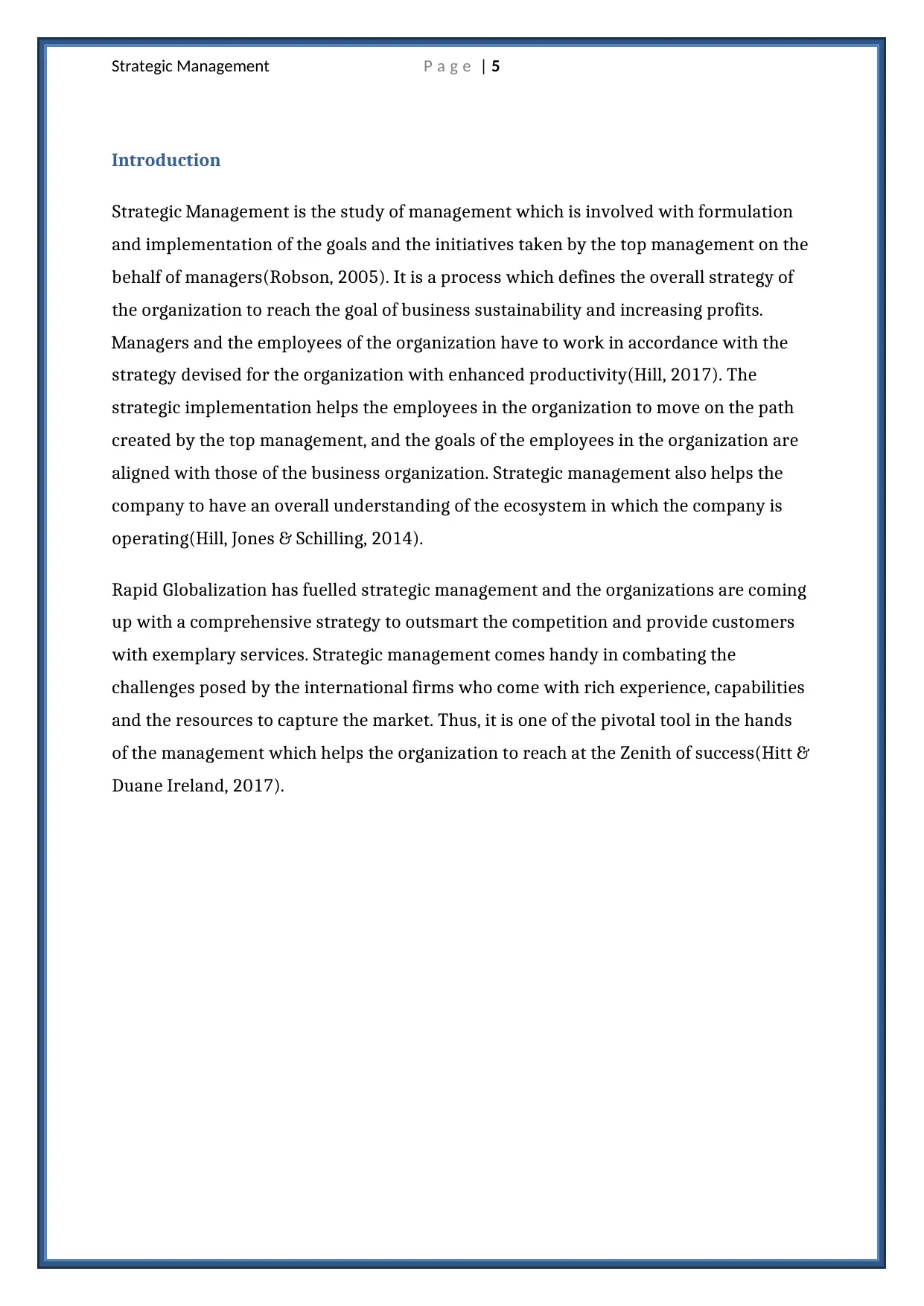
Strategic Management P a g e | 5
Introduction
Strategic Management is the study of management which is involved with formulation
and implementation of the goals and the initiatives taken by the top management on the
behalf of managers(Robson, 2005). It is a process which defines the overall strategy of
the organization to reach the goal of business sustainability and increasing profits.
Managers and the employees of the organization have to work in accordance with the
strategy devised for the organization with enhanced productivity(Hill, 2017). The
strategic implementation helps the employees in the organization to move on the path
created by the top management, and the goals of the employees in the organization are
aligned with those of the business organization. Strategic management also helps the
company to have an overall understanding of the ecosystem in which the company is
operating(Hill, Jones & Schilling, 2014).
Rapid Globalization has fuelled strategic management and the organizations are coming
up with a comprehensive strategy to outsmart the competition and provide customers
with exemplary services. Strategic management comes handy in combating the
challenges posed by the international firms who come with rich experience, capabilities
and the resources to capture the market. Thus, it is one of the pivotal tool in the hands
of the management which helps the organization to reach at the Zenith of success(Hitt &
Duane Ireland, 2017).
Introduction
Strategic Management is the study of management which is involved with formulation
and implementation of the goals and the initiatives taken by the top management on the
behalf of managers(Robson, 2005). It is a process which defines the overall strategy of
the organization to reach the goal of business sustainability and increasing profits.
Managers and the employees of the organization have to work in accordance with the
strategy devised for the organization with enhanced productivity(Hill, 2017). The
strategic implementation helps the employees in the organization to move on the path
created by the top management, and the goals of the employees in the organization are
aligned with those of the business organization. Strategic management also helps the
company to have an overall understanding of the ecosystem in which the company is
operating(Hill, Jones & Schilling, 2014).
Rapid Globalization has fuelled strategic management and the organizations are coming
up with a comprehensive strategy to outsmart the competition and provide customers
with exemplary services. Strategic management comes handy in combating the
challenges posed by the international firms who come with rich experience, capabilities
and the resources to capture the market. Thus, it is one of the pivotal tool in the hands
of the management which helps the organization to reach at the Zenith of success(Hitt &
Duane Ireland, 2017).
⊘ This is a preview!⊘
Do you want full access?
Subscribe today to unlock all pages.

Trusted by 1+ million students worldwide
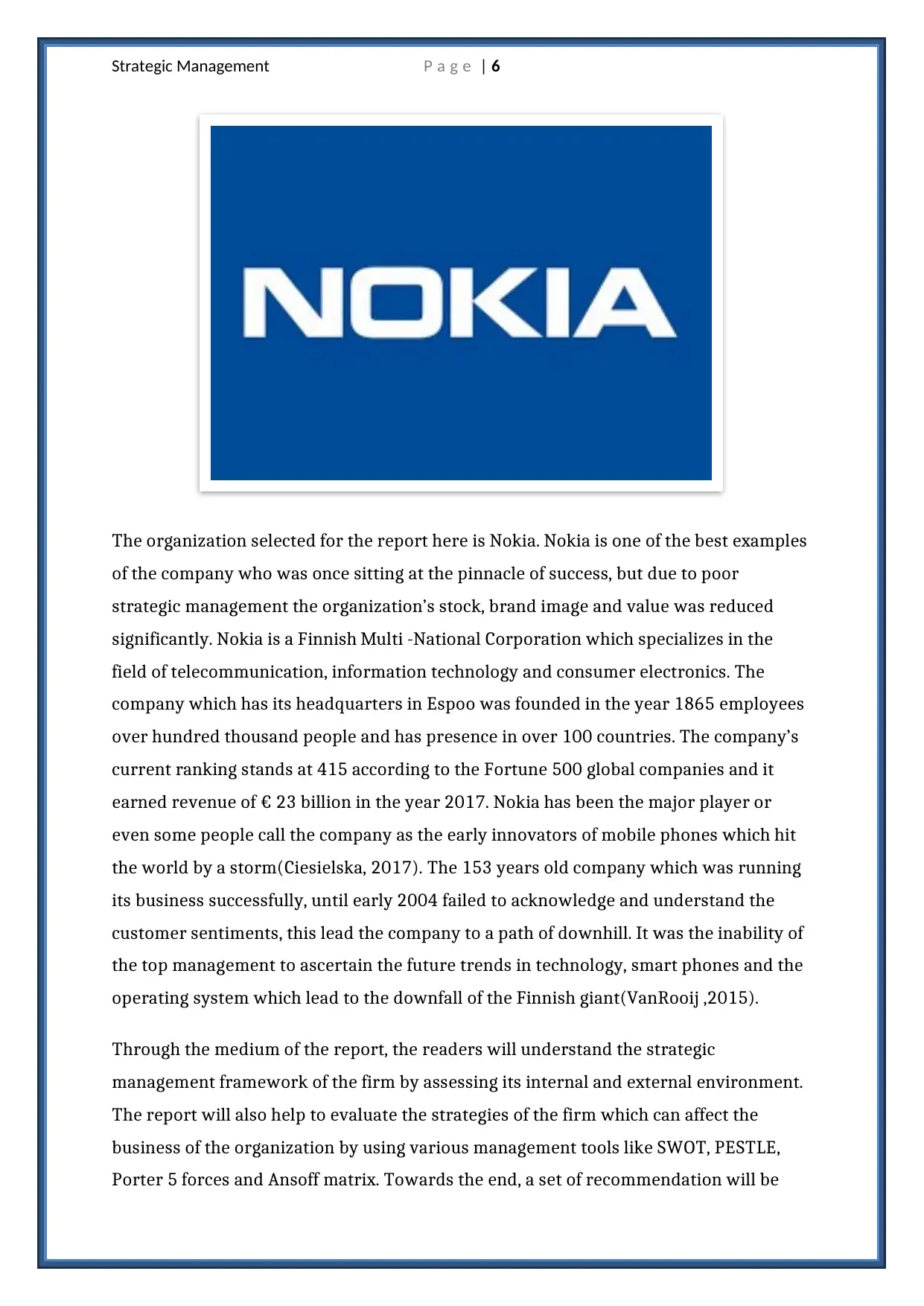
Strategic Management P a g e | 6
The organization selected for the report here is Nokia. Nokia is one of the best examples
of the company who was once sitting at the pinnacle of success, but due to poor
strategic management the organization’s stock, brand image and value was reduced
significantly. Nokia is a Finnish Multi -National Corporation which specializes in the
field of telecommunication, information technology and consumer electronics. The
company which has its headquarters in Espoo was founded in the year 1865 employees
over hundred thousand people and has presence in over 100 countries. The company’s
current ranking stands at 415 according to the Fortune 500 global companies and it
earned revenue of € 23 billion in the year 2017. Nokia has been the major player or
even some people call the company as the early innovators of mobile phones which hit
the world by a storm(Ciesielska, 2017). The 153 years old company which was running
its business successfully, until early 2004 failed to acknowledge and understand the
customer sentiments, this lead the company to a path of downhill. It was the inability of
the top management to ascertain the future trends in technology, smart phones and the
operating system which lead to the downfall of the Finnish giant(VanRooij ,2015).
Through the medium of the report, the readers will understand the strategic
management framework of the firm by assessing its internal and external environment.
The report will also help to evaluate the strategies of the firm which can affect the
business of the organization by using various management tools like SWOT, PESTLE,
Porter 5 forces and Ansoff matrix. Towards the end, a set of recommendation will be
The organization selected for the report here is Nokia. Nokia is one of the best examples
of the company who was once sitting at the pinnacle of success, but due to poor
strategic management the organization’s stock, brand image and value was reduced
significantly. Nokia is a Finnish Multi -National Corporation which specializes in the
field of telecommunication, information technology and consumer electronics. The
company which has its headquarters in Espoo was founded in the year 1865 employees
over hundred thousand people and has presence in over 100 countries. The company’s
current ranking stands at 415 according to the Fortune 500 global companies and it
earned revenue of € 23 billion in the year 2017. Nokia has been the major player or
even some people call the company as the early innovators of mobile phones which hit
the world by a storm(Ciesielska, 2017). The 153 years old company which was running
its business successfully, until early 2004 failed to acknowledge and understand the
customer sentiments, this lead the company to a path of downhill. It was the inability of
the top management to ascertain the future trends in technology, smart phones and the
operating system which lead to the downfall of the Finnish giant(VanRooij ,2015).
Through the medium of the report, the readers will understand the strategic
management framework of the firm by assessing its internal and external environment.
The report will also help to evaluate the strategies of the firm which can affect the
business of the organization by using various management tools like SWOT, PESTLE,
Porter 5 forces and Ansoff matrix. Towards the end, a set of recommendation will be
Paraphrase This Document
Need a fresh take? Get an instant paraphrase of this document with our AI Paraphraser
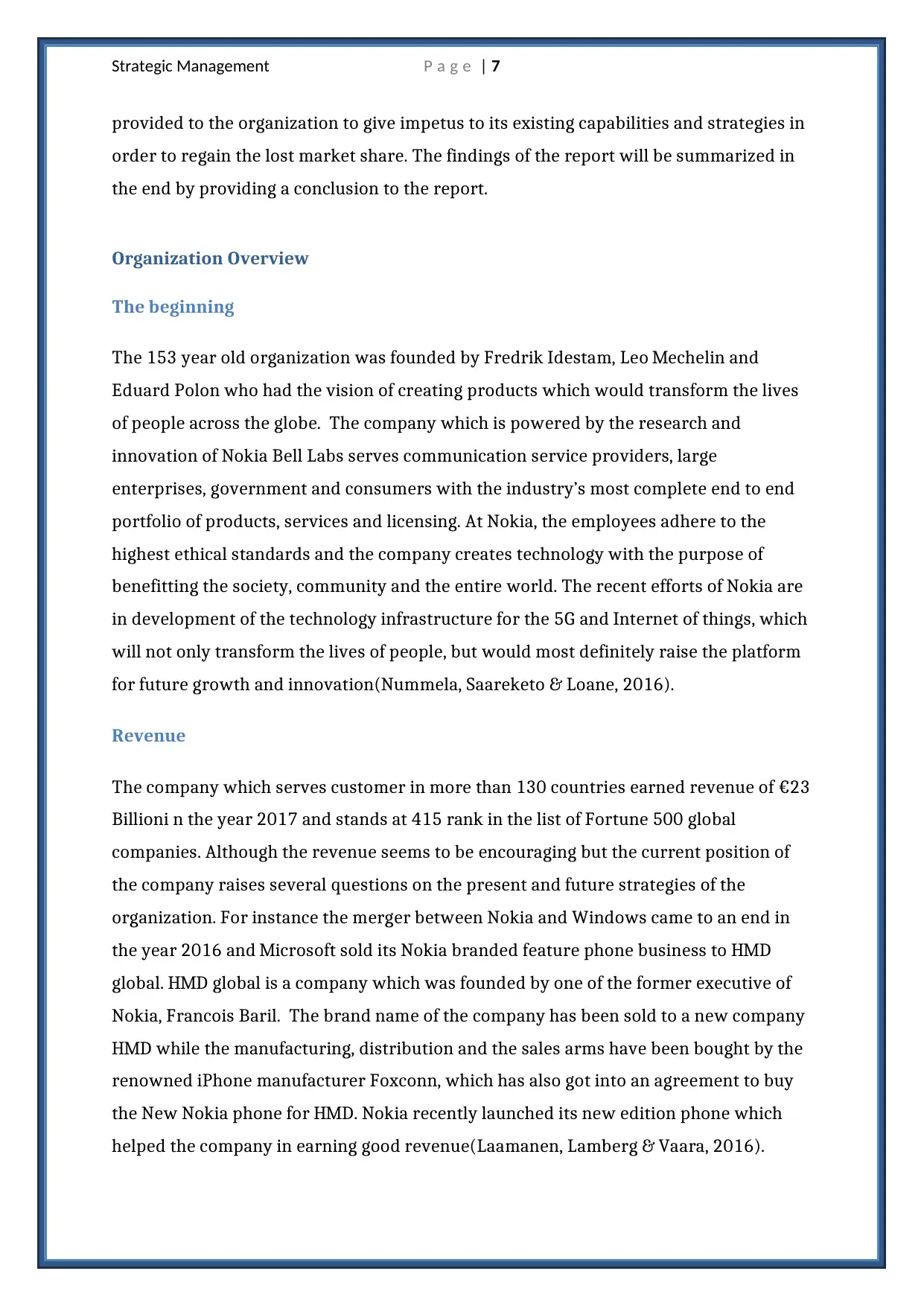
Strategic Management P a g e | 7
provided to the organization to give impetus to its existing capabilities and strategies in
order to regain the lost market share. The findings of the report will be summarized in
the end by providing a conclusion to the report.
Organization Overview
The beginning
The 153 year old organization was founded by Fredrik Idestam, Leo Mechelin and
Eduard Polon who had the vision of creating products which would transform the lives
of people across the globe. The company which is powered by the research and
innovation of Nokia Bell Labs serves communication service providers, large
enterprises, government and consumers with the industry’s most complete end to end
portfolio of products, services and licensing. At Nokia, the employees adhere to the
highest ethical standards and the company creates technology with the purpose of
benefitting the society, community and the entire world. The recent efforts of Nokia are
in development of the technology infrastructure for the 5G and Internet of things, which
will not only transform the lives of people, but would most definitely raise the platform
for future growth and innovation(Nummela, Saareketo & Loane, 2016).
Revenue
The company which serves customer in more than 130 countries earned revenue of €23
Billioni n the year 2017 and stands at 415 rank in the list of Fortune 500 global
companies. Although the revenue seems to be encouraging but the current position of
the company raises several questions on the present and future strategies of the
organization. For instance the merger between Nokia and Windows came to an end in
the year 2016 and Microsoft sold its Nokia branded feature phone business to HMD
global. HMD global is a company which was founded by one of the former executive of
Nokia, Francois Baril. The brand name of the company has been sold to a new company
HMD while the manufacturing, distribution and the sales arms have been bought by the
renowned iPhone manufacturer Foxconn, which has also got into an agreement to buy
the New Nokia phone for HMD. Nokia recently launched its new edition phone which
helped the company in earning good revenue(Laamanen, Lamberg & Vaara, 2016).
provided to the organization to give impetus to its existing capabilities and strategies in
order to regain the lost market share. The findings of the report will be summarized in
the end by providing a conclusion to the report.
Organization Overview
The beginning
The 153 year old organization was founded by Fredrik Idestam, Leo Mechelin and
Eduard Polon who had the vision of creating products which would transform the lives
of people across the globe. The company which is powered by the research and
innovation of Nokia Bell Labs serves communication service providers, large
enterprises, government and consumers with the industry’s most complete end to end
portfolio of products, services and licensing. At Nokia, the employees adhere to the
highest ethical standards and the company creates technology with the purpose of
benefitting the society, community and the entire world. The recent efforts of Nokia are
in development of the technology infrastructure for the 5G and Internet of things, which
will not only transform the lives of people, but would most definitely raise the platform
for future growth and innovation(Nummela, Saareketo & Loane, 2016).
Revenue
The company which serves customer in more than 130 countries earned revenue of €23
Billioni n the year 2017 and stands at 415 rank in the list of Fortune 500 global
companies. Although the revenue seems to be encouraging but the current position of
the company raises several questions on the present and future strategies of the
organization. For instance the merger between Nokia and Windows came to an end in
the year 2016 and Microsoft sold its Nokia branded feature phone business to HMD
global. HMD global is a company which was founded by one of the former executive of
Nokia, Francois Baril. The brand name of the company has been sold to a new company
HMD while the manufacturing, distribution and the sales arms have been bought by the
renowned iPhone manufacturer Foxconn, which has also got into an agreement to buy
the New Nokia phone for HMD. Nokia recently launched its new edition phone which
helped the company in earning good revenue(Laamanen, Lamberg & Vaara, 2016).
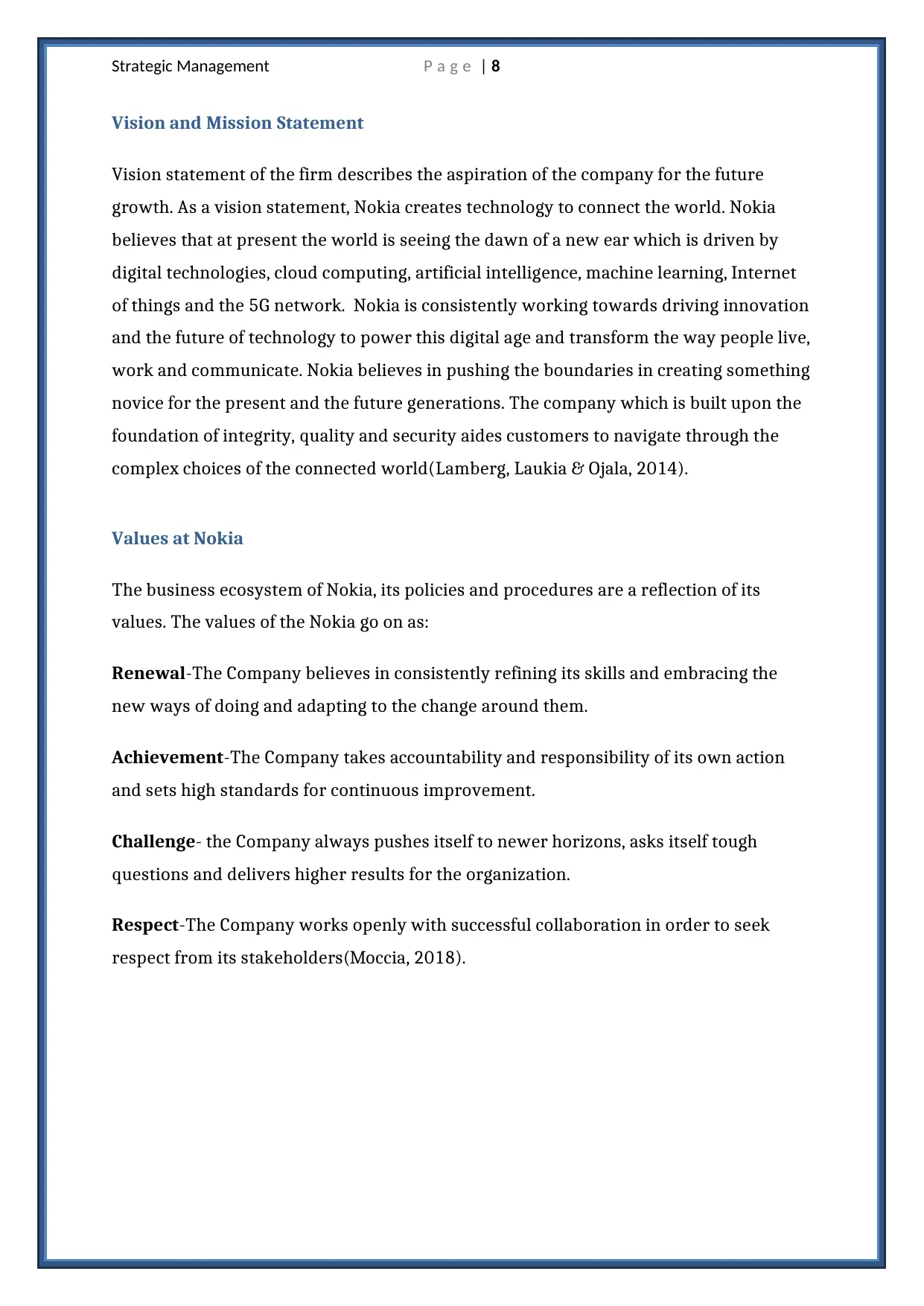
Strategic Management P a g e | 8
Vision and Mission Statement
Vision statement of the firm describes the aspiration of the company for the future
growth. As a vision statement, Nokia creates technology to connect the world. Nokia
believes that at present the world is seeing the dawn of a new ear which is driven by
digital technologies, cloud computing, artificial intelligence, machine learning, Internet
of things and the 5G network. Nokia is consistently working towards driving innovation
and the future of technology to power this digital age and transform the way people live,
work and communicate. Nokia believes in pushing the boundaries in creating something
novice for the present and the future generations. The company which is built upon the
foundation of integrity, quality and security aides customers to navigate through the
complex choices of the connected world(Lamberg, Laukia & Ojala, 2014).
Values at Nokia
The business ecosystem of Nokia, its policies and procedures are a reflection of its
values. The values of the Nokia go on as:
Renewal-The Company believes in consistently refining its skills and embracing the
new ways of doing and adapting to the change around them.
Achievement-The Company takes accountability and responsibility of its own action
and sets high standards for continuous improvement.
Challenge- the Company always pushes itself to newer horizons, asks itself tough
questions and delivers higher results for the organization.
Respect-The Company works openly with successful collaboration in order to seek
respect from its stakeholders(Moccia, 2018).
Vision and Mission Statement
Vision statement of the firm describes the aspiration of the company for the future
growth. As a vision statement, Nokia creates technology to connect the world. Nokia
believes that at present the world is seeing the dawn of a new ear which is driven by
digital technologies, cloud computing, artificial intelligence, machine learning, Internet
of things and the 5G network. Nokia is consistently working towards driving innovation
and the future of technology to power this digital age and transform the way people live,
work and communicate. Nokia believes in pushing the boundaries in creating something
novice for the present and the future generations. The company which is built upon the
foundation of integrity, quality and security aides customers to navigate through the
complex choices of the connected world(Lamberg, Laukia & Ojala, 2014).
Values at Nokia
The business ecosystem of Nokia, its policies and procedures are a reflection of its
values. The values of the Nokia go on as:
Renewal-The Company believes in consistently refining its skills and embracing the
new ways of doing and adapting to the change around them.
Achievement-The Company takes accountability and responsibility of its own action
and sets high standards for continuous improvement.
Challenge- the Company always pushes itself to newer horizons, asks itself tough
questions and delivers higher results for the organization.
Respect-The Company works openly with successful collaboration in order to seek
respect from its stakeholders(Moccia, 2018).
⊘ This is a preview!⊘
Do you want full access?
Subscribe today to unlock all pages.

Trusted by 1+ million students worldwide
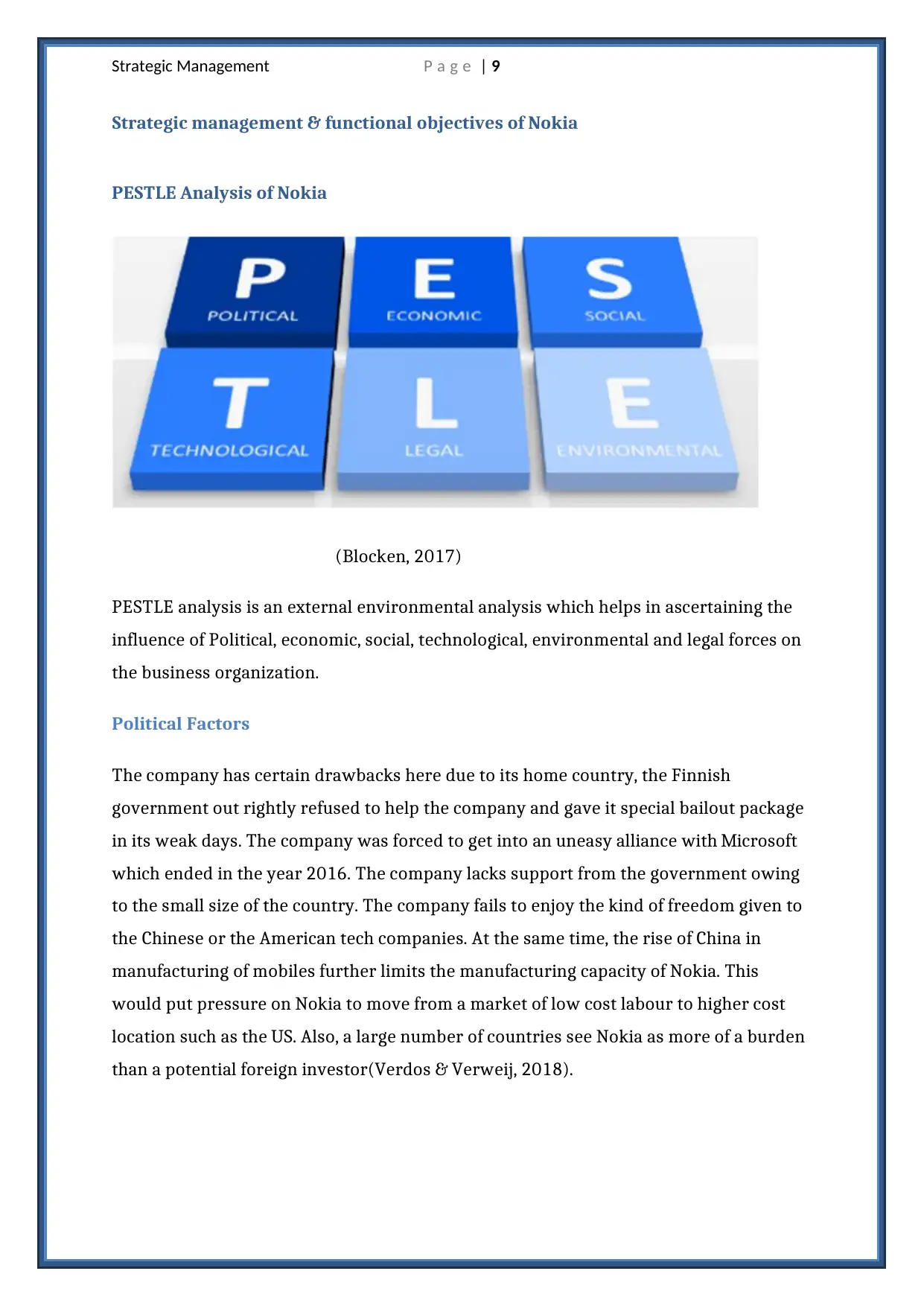
Strategic Management P a g e | 9
Strategic management & functional objectives of Nokia
PESTLE Analysis of Nokia
(Blocken, 2017)
PESTLE analysis is an external environmental analysis which helps in ascertaining the
influence of Political, economic, social, technological, environmental and legal forces on
the business organization.
Political Factors
The company has certain drawbacks here due to its home country, the Finnish
government out rightly refused to help the company and gave it special bailout package
in its weak days. The company was forced to get into an uneasy alliance with Microsoft
which ended in the year 2016. The company lacks support from the government owing
to the small size of the country. The company fails to enjoy the kind of freedom given to
the Chinese or the American tech companies. At the same time, the rise of China in
manufacturing of mobiles further limits the manufacturing capacity of Nokia. This
would put pressure on Nokia to move from a market of low cost labour to higher cost
location such as the US. Also, a large number of countries see Nokia as more of a burden
than a potential foreign investor(Verdos & Verweij, 2018).
Strategic management & functional objectives of Nokia
PESTLE Analysis of Nokia
(Blocken, 2017)
PESTLE analysis is an external environmental analysis which helps in ascertaining the
influence of Political, economic, social, technological, environmental and legal forces on
the business organization.
Political Factors
The company has certain drawbacks here due to its home country, the Finnish
government out rightly refused to help the company and gave it special bailout package
in its weak days. The company was forced to get into an uneasy alliance with Microsoft
which ended in the year 2016. The company lacks support from the government owing
to the small size of the country. The company fails to enjoy the kind of freedom given to
the Chinese or the American tech companies. At the same time, the rise of China in
manufacturing of mobiles further limits the manufacturing capacity of Nokia. This
would put pressure on Nokia to move from a market of low cost labour to higher cost
location such as the US. Also, a large number of countries see Nokia as more of a burden
than a potential foreign investor(Verdos & Verweij, 2018).
Paraphrase This Document
Need a fresh take? Get an instant paraphrase of this document with our AI Paraphraser
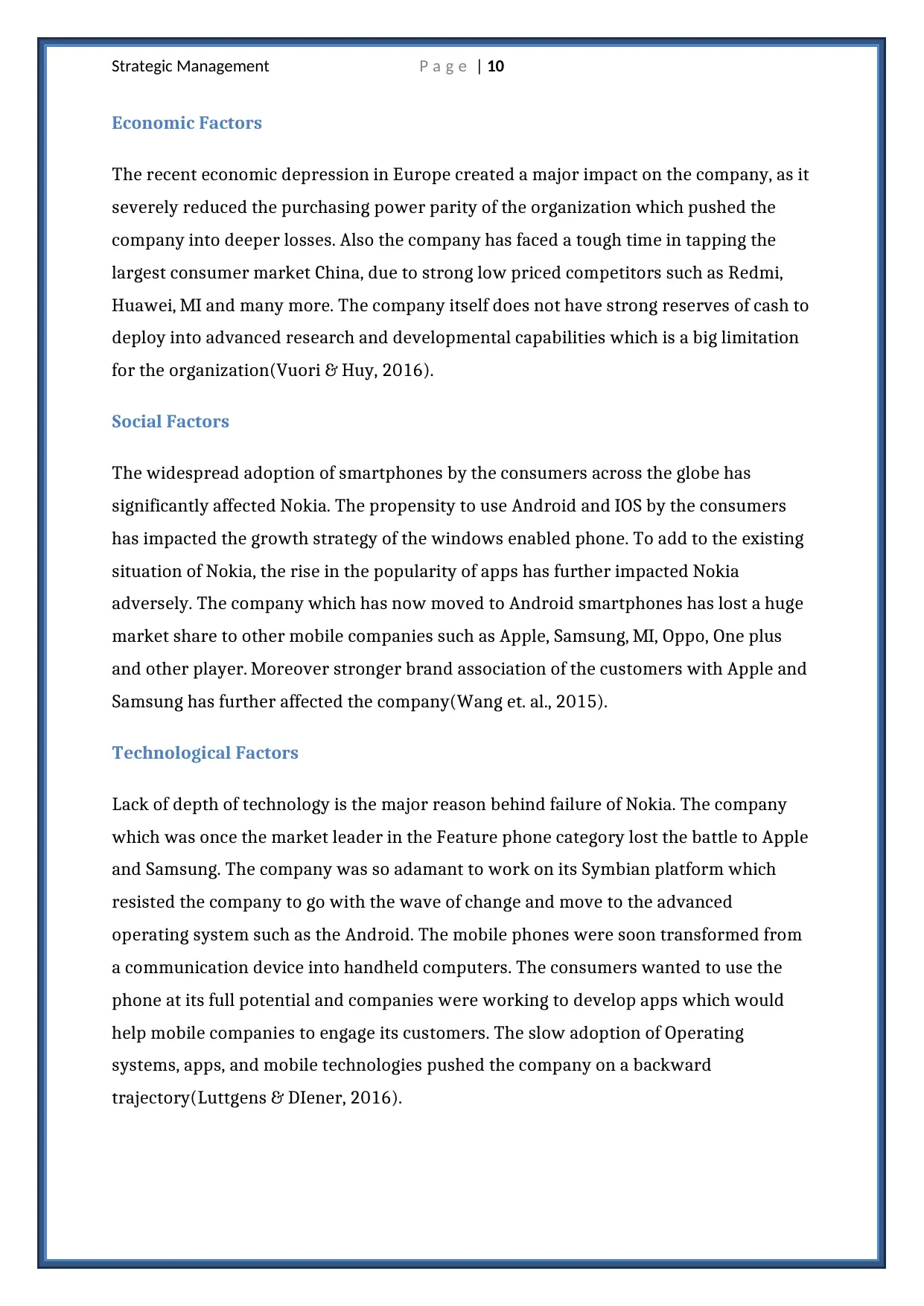
Strategic Management P a g e | 10
Economic Factors
The recent economic depression in Europe created a major impact on the company, as it
severely reduced the purchasing power parity of the organization which pushed the
company into deeper losses. Also the company has faced a tough time in tapping the
largest consumer market China, due to strong low priced competitors such as Redmi,
Huawei, MI and many more. The company itself does not have strong reserves of cash to
deploy into advanced research and developmental capabilities which is a big limitation
for the organization(Vuori & Huy, 2016).
Social Factors
The widespread adoption of smartphones by the consumers across the globe has
significantly affected Nokia. The propensity to use Android and IOS by the consumers
has impacted the growth strategy of the windows enabled phone. To add to the existing
situation of Nokia, the rise in the popularity of apps has further impacted Nokia
adversely. The company which has now moved to Android smartphones has lost a huge
market share to other mobile companies such as Apple, Samsung, MI, Oppo, One plus
and other player. Moreover stronger brand association of the customers with Apple and
Samsung has further affected the company(Wang et. al., 2015).
Technological Factors
Lack of depth of technology is the major reason behind failure of Nokia. The company
which was once the market leader in the Feature phone category lost the battle to Apple
and Samsung. The company was so adamant to work on its Symbian platform which
resisted the company to go with the wave of change and move to the advanced
operating system such as the Android. The mobile phones were soon transformed from
a communication device into handheld computers. The consumers wanted to use the
phone at its full potential and companies were working to develop apps which would
help mobile companies to engage its customers. The slow adoption of Operating
systems, apps, and mobile technologies pushed the company on a backward
trajectory(Luttgens & DIener, 2016).
Economic Factors
The recent economic depression in Europe created a major impact on the company, as it
severely reduced the purchasing power parity of the organization which pushed the
company into deeper losses. Also the company has faced a tough time in tapping the
largest consumer market China, due to strong low priced competitors such as Redmi,
Huawei, MI and many more. The company itself does not have strong reserves of cash to
deploy into advanced research and developmental capabilities which is a big limitation
for the organization(Vuori & Huy, 2016).
Social Factors
The widespread adoption of smartphones by the consumers across the globe has
significantly affected Nokia. The propensity to use Android and IOS by the consumers
has impacted the growth strategy of the windows enabled phone. To add to the existing
situation of Nokia, the rise in the popularity of apps has further impacted Nokia
adversely. The company which has now moved to Android smartphones has lost a huge
market share to other mobile companies such as Apple, Samsung, MI, Oppo, One plus
and other player. Moreover stronger brand association of the customers with Apple and
Samsung has further affected the company(Wang et. al., 2015).
Technological Factors
Lack of depth of technology is the major reason behind failure of Nokia. The company
which was once the market leader in the Feature phone category lost the battle to Apple
and Samsung. The company was so adamant to work on its Symbian platform which
resisted the company to go with the wave of change and move to the advanced
operating system such as the Android. The mobile phones were soon transformed from
a communication device into handheld computers. The consumers wanted to use the
phone at its full potential and companies were working to develop apps which would
help mobile companies to engage its customers. The slow adoption of Operating
systems, apps, and mobile technologies pushed the company on a backward
trajectory(Luttgens & DIener, 2016).
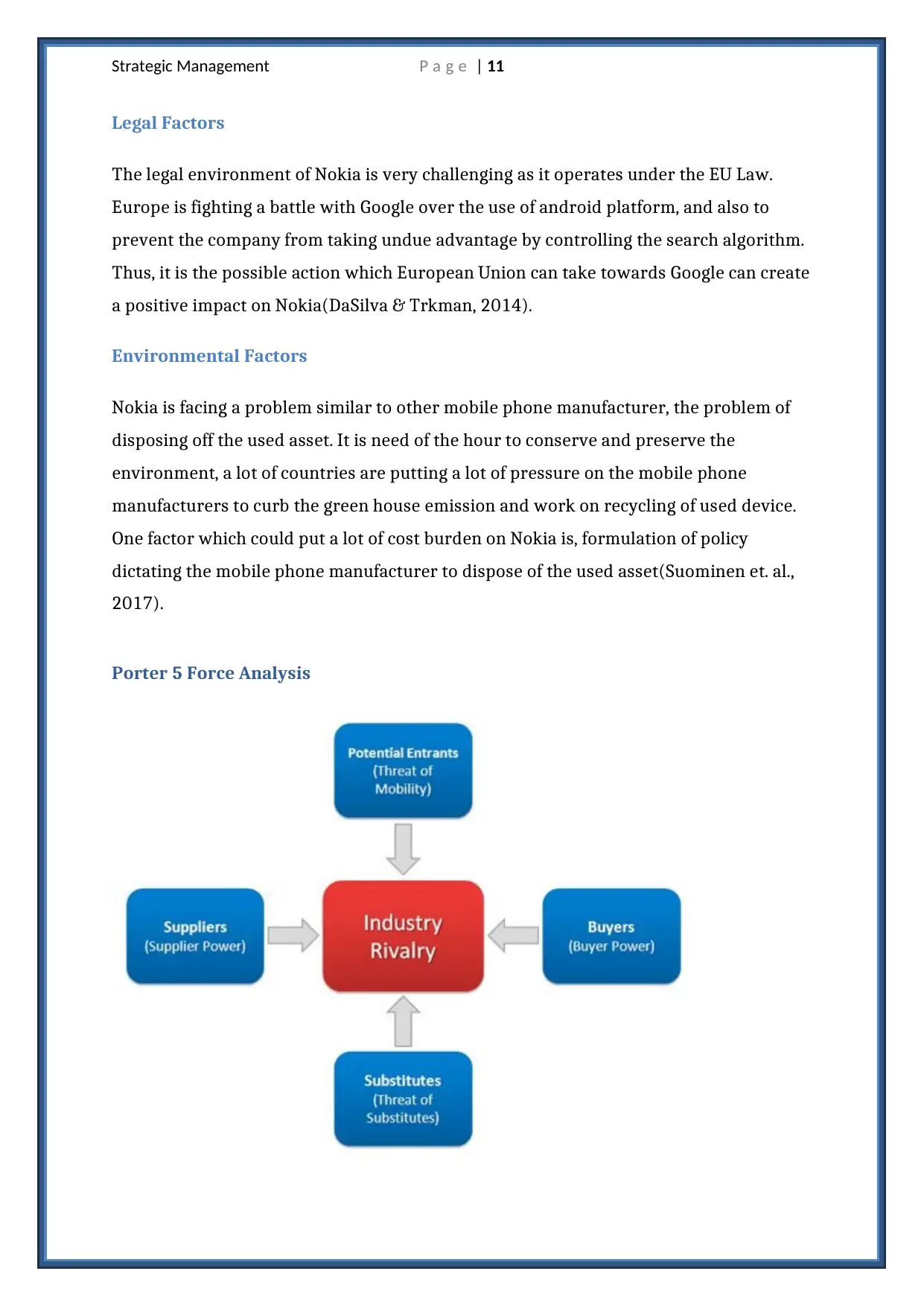
Strategic Management P a g e | 11
Legal Factors
The legal environment of Nokia is very challenging as it operates under the EU Law.
Europe is fighting a battle with Google over the use of android platform, and also to
prevent the company from taking undue advantage by controlling the search algorithm.
Thus, it is the possible action which European Union can take towards Google can create
a positive impact on Nokia(DaSilva & Trkman, 2014).
Environmental Factors
Nokia is facing a problem similar to other mobile phone manufacturer, the problem of
disposing off the used asset. It is need of the hour to conserve and preserve the
environment, a lot of countries are putting a lot of pressure on the mobile phone
manufacturers to curb the green house emission and work on recycling of used device.
One factor which could put a lot of cost burden on Nokia is, formulation of policy
dictating the mobile phone manufacturer to dispose of the used asset(Suominen et. al.,
2017).
Porter 5 Force Analysis
Legal Factors
The legal environment of Nokia is very challenging as it operates under the EU Law.
Europe is fighting a battle with Google over the use of android platform, and also to
prevent the company from taking undue advantage by controlling the search algorithm.
Thus, it is the possible action which European Union can take towards Google can create
a positive impact on Nokia(DaSilva & Trkman, 2014).
Environmental Factors
Nokia is facing a problem similar to other mobile phone manufacturer, the problem of
disposing off the used asset. It is need of the hour to conserve and preserve the
environment, a lot of countries are putting a lot of pressure on the mobile phone
manufacturers to curb the green house emission and work on recycling of used device.
One factor which could put a lot of cost burden on Nokia is, formulation of policy
dictating the mobile phone manufacturer to dispose of the used asset(Suominen et. al.,
2017).
Porter 5 Force Analysis
⊘ This is a preview!⊘
Do you want full access?
Subscribe today to unlock all pages.

Trusted by 1+ million students worldwide
1 out of 28
Related Documents
Your All-in-One AI-Powered Toolkit for Academic Success.
+13062052269
info@desklib.com
Available 24*7 on WhatsApp / Email
![[object Object]](/_next/static/media/star-bottom.7253800d.svg)
Unlock your academic potential
Copyright © 2020–2025 A2Z Services. All Rights Reserved. Developed and managed by ZUCOL.




